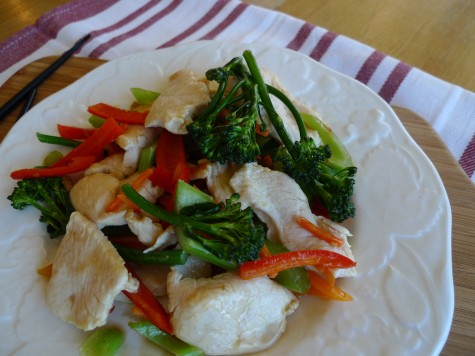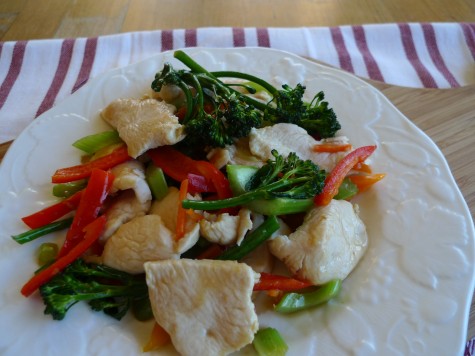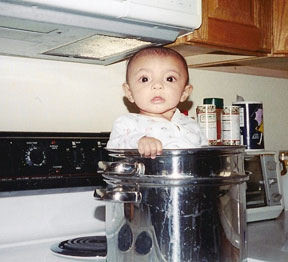As I’ve mentioned before, my Daddy-o is primarily a meat-and-potatoes man. When he sits down to dinner, he wants his grilled steak or his juicy pork chop, and he wants some form of potato sittin’ right next to it. If he has those, he’s a happy man. He doesn’t want fanfare, he doesn’t want fancy and he definitely doesn’t want some newfangled ingredient or exotic spice added to his meal.
When I was a little kid, that suited me just fine. I was pretty dang suspicious of any food I didn’t recognize, either. Whenever Mama introduced a new type of casserole (or, God forbid, one of her “experiments”), I was one tough customer. I’d scrutinize the interloper on my plate with an eagle eye, poking around investigatively for some offending or off-putting ingredient. In short, I was a total pain in the ass. It’s a wonder my mother ever tried anything new in the kitchen.
My attitude about food began to change I was eleven or twelve, when my mother enrolled me in 4-H after school. This particular branch of 4-H was decidedly suburban–we didn’t do anything out of doors, like raise animals or grow giant pumpkins or build survival shelters in the woods. My 4-H group did two things: cook and sew.
I absolutely loathed the sewing part of the equation and would put off my sewing projects to the point where Mama, fed up with my protesting, would finish them for me in a disappointed huff. The cooking part, though? I loved it. Cooking was like science and magic woven together. It fascinated me how you could start out with a few ordinary ingredients and with a little tinkering and bubbling and stirring, transform those simple things into something quite magnificent. It felt like sorcery–in a good way.
As my skill in the kitchen improved, I became more inclined to try new flavors and techniques. Some of these adventures didn’t turn out so well, like the saltwater taffy that never hardened and the doughnut holes that exploded on the stovetop. A few times, in the midst of utter failure, I dissolved into tears and stomped out of the kitchen in a fit of pique. But I always came back, wanting to try again.
That’s saying something, since I’ve pretty much made a career of quitting things. For some reason, cooking stuck.
Daddy was a fairly good sport about my efforts in the kitchen, although he made it clear that he had limits. When I flirted with vegetarianism, he made many desperate, post-dinner trips to the local McDonald’s and anything I created involving fish was met with a shudder and a hangdog face. Still, for a meat-and-potatoes guy, he did pretty admirably.
One of my first “experiments” I tried in the kitchen that pushed me out of my comfort zone a bit was a Chinese chicken stir fry. I’d only eaten restaurant Chinese food a handful of times (again, Daddy’s meat and potato fixation tended to dictate our dining-out habits), so I didn’t really have a frame of reference in the “Asian” department. And when I did order off a Chinese menu, I tended to stick with fairly milk-toast offerings, like Moo Goo Gai Pan. That’s about the safest dish a girl could order…except for maybe chow mein, which really isn’t a Chinese dish at all.
My home-cooked stir fry turned out passable, but I was disappointed in the chicken part of the equation. It wasn’t the delicate, feather-light texture of the chicken I’d eaten in my Moo Goo Gai pan at the neighborhood Jade Garden. I decided that maybe it was a technique issue, since we certainly didn’t own anything as exotic as a wok in my family kitchen. I made my stir fry in a good old skillet that was probably purchased before I was born.
It wasn’t until years later, when I owned my first apartment and purchased an actual wok (a bit of folly on my part) that I realized that the wok didn’t solve my chicken problem. My chicken was still kind of rubbery-textured. Hmph.
What kind of magic trick were the Chinese restaurants pulling? Were they just Chicken Whisperers or something?
I endured quite a few more years of mediocre stir-fry until I stumbled on a recipe from the folks at Fine Cooking magazine that explained the Chinese method of “velveting” chicken. Viola! I had my answer.
“Velveting” chicken involves a little extra attention, but it’s not really difficult, and in my opinion, it’s well worth the effort. Basically, you marinate the chicken in a mixture of egg white and cornstarch (and a few seasonings), chill it, and then blanch it in a pot of near-simmering oil or water for the teeniest bit of time–until the chicken is barely cooked through. Then, you set the chicken aside, stir fry some vegetables, toss in your favorite stir-fry sauce (I’ve included mine here) and add the chicken at the last second to heat.
Pretty simple, eh? And you get juicy, tender, magical chicken as your reward.
You’re welcome.
No fancy wok or Chinese sorcery necessary. The next time you’re tempted to order takeout, consider making this recipe. I velveted my chicken in water, with great results. You can use oil, but why would you bother? Water is more cost-effective and certainly better for the backside, which this home cook definitely appreciates. Chinese takeout can be backside suicide, but this recipe lets you have your chicken and eat it without guilt. Maybe it is a chicken miracle.
“Velveted” Chicken
from Fine Cooking magazine
makes enough chicken to serve 4
1 extra-large egg white
1 tablespoon dry sherry or good-quality Chinese rice wine
1 tablespoon cornstarch
1 teaspoon kosher salt
1 pound chicken breast, cut into very thin strips or shreds
4 cups water or 3-4 cups corn, peanut or canola oil
In a mini food processor or blender, blend the egg white, sherry/wine, cornstarch and salt until smooth and thick, about 2 minutes. Place the chicken in a bowl and using your hands, toss chicken with the egg white mixture until thoroughly coated. Separate the chicken pieces a bit. Cover and refrigerate for 30 minutes (or overnight).
Shortly before stir-frying, bring the water or oil to a steaming, near simmer (if you use a thermometer, it’s about 275 degrees). Next to the stove, set a place big enough to hold the chicken in a single layer. Have a large mesh spoon nearby or a colander waiting in the sink (if blanching in oil, don’t use the colander methos–use the slotted spoon).
Toss the chicken once more with the marinade and slide it into the hot water or oil, leaving any excess marinade behind. Gently stir the chicken with chopsticks to separate the pieces. Watch carefully! You want the chicken to just barely turn about 95% white–5-10 seconds for shreds or thin slices.
Scoop out the chicken promptly with the mesh spoon or drain it in the colander. Immediately transfer to the place and spread chicken out in one layer.
Then, stir-fry your vegetables in some oil, add your favorite stir fry sauce, toss in the chicken for the last couple of seconds, and enjoy!
Stir-Fry Sauce
makes enough to coat chicken and vegetables for 4
2 teaspoons finely grated fresh ginger
2 teaspoons minced garlic
a few sliced scallions
1/2 teaspoons crushed red pepper flakes (or Sriracha)–optional
1/2 cup chicken broth, preferably low-sodium
1/4 cup fresh lemon juice
zest of one lemon
2 tablespoons soy sauce
1 tablespoon sugar
1/2 teaspoon kosher salt
1 teaspoon cornstarch
Whisk all ingredients together and add to your stir fried veggies, and cook a few seconds until a bit thickened. Add velveted chicken and serve immediately.




{ 4 comments… read them below or add one }
Is this true, Dana?
I want to believe it. I kind of don’t, but then, this blog is called The Kitchen Witch.
So, I’m going to chance it.
I will let you know!!
Alexandra,
It works, honest! Good luck!
How cool! I’ve never come across this technique before. Now I have to give it a try!
Great tip – thank you! Going to try this…